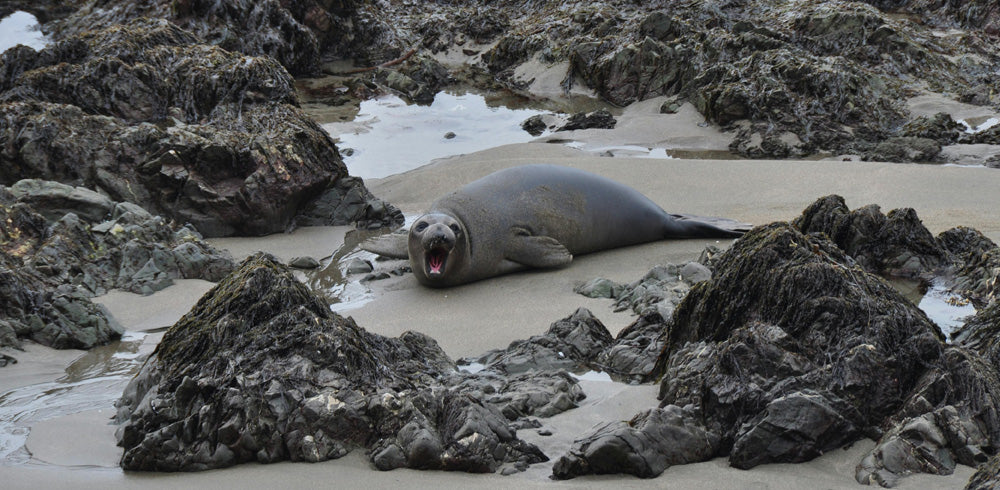Grey Seals
The grey seal, also known as the Atlantic seal, can be found in abundance along the coastlines of the United Kingdom. These creatures are known for their distinctive grey coloring and playful nature, but there is much more to learn about them than meets the eye.
Grey seals are one of the largest seal species in the UK, with males reaching lengths of up to 2.5 meters and weighing as much as 300 kilograms. Females are slightly smaller, typically reaching lengths of around 2 meters and weighing up to 200 kilograms. Despite their size, grey seals are incredibly agile swimmers, able to dive to depths of over 70 meters and hold their breath for up to 20 minutes.
One of the most interesting facts about grey seals is their diet. These carnivorous creatures primarily feed on fish, such as herring, cod, and sand eels, as well as squid and crustaceans. They are known to be opportunistic feeders, meaning they will eat whatever is readily available to them. This can sometimes lead to conflicts with fishermen, as grey seals have been known to raid fishing nets and steal catches.
Grey seals are also known for their unique habitat preferences. They can be found along the rocky coastlines of the UK, where they haul out onto land to rest, breed, and give birth. During the breeding season, which typically occurs between September and December, large colonies of grey seals can be seen on beaches and rocky outcrops, where they gather to mate and raise their young.
Despite their abundance in UK waters, grey seals are a protected species under UK law. This means that it is illegal to harm, disturb, or harass them in any way. This protection has been put in place to help conserve the population of grey seals, which has faced threats from habitat destruction, pollution, and hunting in the past.
During the winter months, grey seals can often be seen hauled out on land, where they hibernate to conserve energy and stay warm. This behavior is known as “hauling out” and is a common sight along the coastlines of the UK. During this time, grey seals will fast and rely on their blubber reserves to sustain them until they return to the water in the spring.
While grey seals are not currently considered endangered, they do face threats from human activities such as fishing, pollution, and climate change. Conservation efforts are underway to protect these magnificent creatures and ensure their survival for future generations to enjoy.
In some areas, grey seals have come into conflict with farmers, as they have been known to prey on livestock such as sheep and lambs. This has led to calls for culls of grey seals in certain regions, but conservationists argue that non-lethal methods of deterrence should be used instead.
In conclusion, grey seals are a fascinating and important species in the UK that play a vital role in the marine ecosystem. With their distinctive grey coloring, playful nature, and impressive swimming abilities, these creatures are a true marvel of the natural world. By learning more about grey seals and the challenges they face, we can all do our part to help protect and conserve these magnificent animals for generations to come.
Grey seals are one of the largest seal species in the UK, with males reaching lengths of up to 2.5 meters and weighing as much as 300 kilograms. Females are slightly smaller, typically reaching lengths of around 2 meters and weighing up to 200 kilograms. Despite their size, grey seals are incredibly agile swimmers, able to dive to depths of over 70 meters and hold their breath for up to 20 minutes.
One of the most interesting facts about grey seals is their diet. These carnivorous creatures primarily feed on fish, such as herring, cod, and sand eels, as well as squid and crustaceans. They are known to be opportunistic feeders, meaning they will eat whatever is readily available to them. This can sometimes lead to conflicts with fishermen, as grey seals have been known to raid fishing nets and steal catches.
Grey seals are also known for their unique habitat preferences. They can be found along the rocky coastlines of the UK, where they haul out onto land to rest, breed, and give birth. During the breeding season, which typically occurs between September and December, large colonies of grey seals can be seen on beaches and rocky outcrops, where they gather to mate and raise their young.
Despite their abundance in UK waters, grey seals are a protected species under UK law. This means that it is illegal to harm, disturb, or harass them in any way. This protection has been put in place to help conserve the population of grey seals, which has faced threats from habitat destruction, pollution, and hunting in the past.
During the winter months, grey seals can often be seen hauled out on land, where they hibernate to conserve energy and stay warm. This behavior is known as “hauling out” and is a common sight along the coastlines of the UK. During this time, grey seals will fast and rely on their blubber reserves to sustain them until they return to the water in the spring.
While grey seals are not currently considered endangered, they do face threats from human activities such as fishing, pollution, and climate change. Conservation efforts are underway to protect these magnificent creatures and ensure their survival for future generations to enjoy.
In some areas, grey seals have come into conflict with farmers, as they have been known to prey on livestock such as sheep and lambs. This has led to calls for culls of grey seals in certain regions, but conservationists argue that non-lethal methods of deterrence should be used instead.
In conclusion, grey seals are a fascinating and important species in the UK that play a vital role in the marine ecosystem. With their distinctive grey coloring, playful nature, and impressive swimming abilities, these creatures are a true marvel of the natural world. By learning more about grey seals and the challenges they face, we can all do our part to help protect and conserve these magnificent animals for generations to come.




























